Pros
Cons
Introduction
Front
{{section_header}}{{section.name}}{{/section_header}}
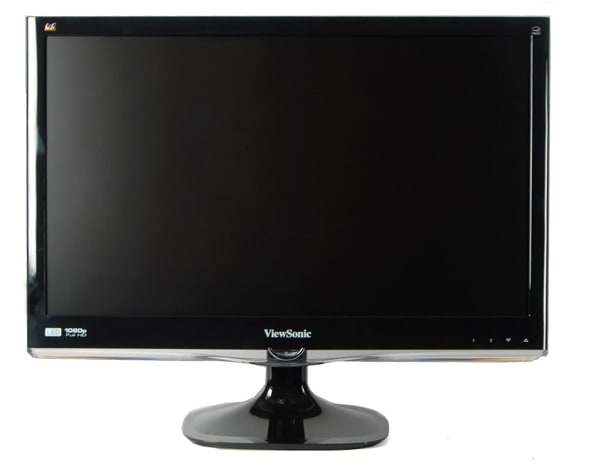
Back
{{section_header}}{{section.name}}{{/section_header}}

Sides
{{section_header}}{{section.name}}{{/section_header}}
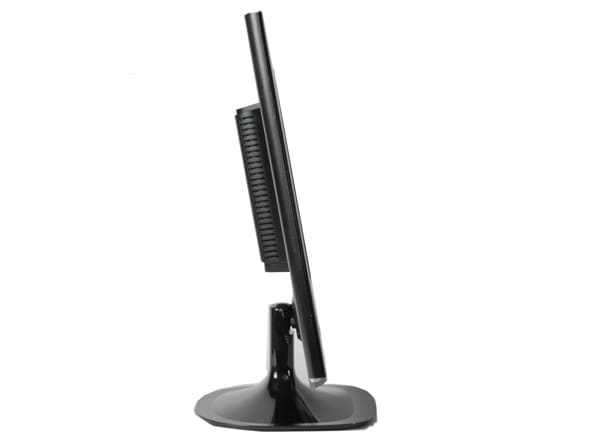
In the Box
{{section_header}}{{section.name}}{{/section_header}}
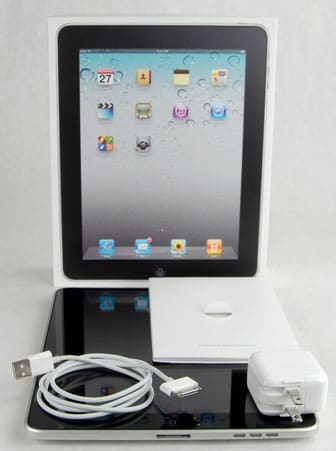
Along with your large tablet, the parcel containing your goodies contains a USB cable, wall charger, and assorted documentation.
Handling
{{section_header}}{{section.name}}{{/section_header}}
There's been much pooh-poohing from Apple fans about the {{product.name}}'s plastic body, but that theoretically inferior casing allowed Samsung, the manufacturer tapped by Google, to put a rubbery coating on the back of the tablet, allowing for much easier grip. The tablet is a bit on the heavy side, but overall isn't that difficult to handle without fatigue. You may find that you periodically cover the speakers on the front with your thumbs by accident, but Samsung has yet to figure out a good placement for those.
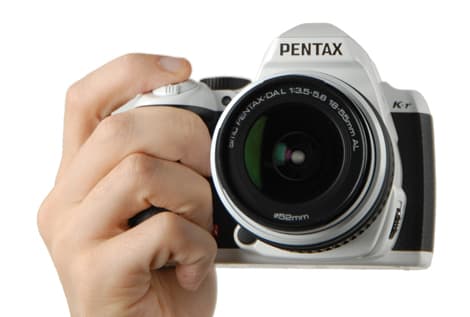
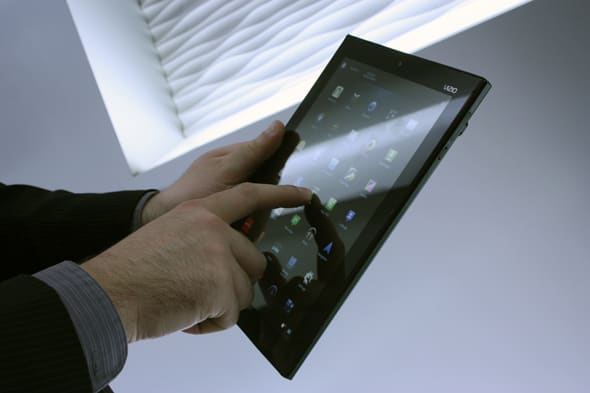
Screen
{{section_header}}{{section.name}}{{/section_header}}
Measuring in at 8.5625 x 5.375 inches, the {{product.name}}'s display is thoroughly average among the larger tablets out there in terms of gross size, but it has impressive measurables like a bright screen and unprecedented pixel density. Couple that in with an anti-glare coating, and you've got yourself an impressive screen with an unusual LCD. Instead of an IPS (in-plane switching) display, it uses a plane-to-line display (PLS) that increases viewing angle and potential brightness.

Indoor & Outdoor Use
{{section_header}}{{section.name}}{{/section_header}}
As a result of its low reflectivity and relatively high peak brightness, the {{product.name}} can be taken outside, though like most tablets, it does not handle direct sunlight very well. Because LCD screen rely on their own backlight to make their image seen, bright ambient light can overpower the backlight and make your picture seem washed out.
NOTE: The images above are shot with a variety of lighting sources, which may cause some color shift.
Legibility
With a density of 299 pixels per inch, the Google Nexus10 has a screen that can display images more crisp than any other tablet currently. Even if you have better than 20/20 vision, you are unlikely to see any pixels in normal use, unless your source material (like images, video) are of a lower resolution.
Reflectance
Though it’s an uncommon feature, the Google Nexus10 s actually have an anti-reflective coating that does a fairly good job overall at dispelling annoying reflection patterns from your screen. Only reflecting 3.8% of ambient light back at the user, the Google Nexus10 ’s screen scores well in this area.
Screen Size & DPI
By cramming in 2560 × 1600 pixels into a display that occupies 8.5625 × 5.375 inches of real estate, the Google Nexus10 has a pixel density of 299 PPI (pixels per inch), which at the time of release is the highest on the market. What does this mean for you? Well, in addition to being able to view high-resolution media on a large screen with no visible pixel lines, you’ll have one of the most crisp screen images available to tablet owners.
Blacks and Whites
Despite the Google Nexus10 ‘s high peak brightness of 432.48cd/m2 the contrast ratio of the tablet is cut short by the high black level of 0.64cd/m2 . A wide contrast ratio (anything above 1000:1) is important in order to display a large number of values in greyscale for picture detail, but when it’s narrow (for example, the Nexus10 ’s 686:1 ratio), your picture will look washed out.
Color Gamut
Yikes. This is bad, especially when you consider just how far other displays have come in the last year. While the white point is just about where it should be, none of the reds, greens, or blues are in a good spot. Reds and greens are undersaturated, meaning the deepest values of each are not as intense as they should be, and blues are shifted wildly to a more cyan-ish color.
Battery Life
After subjecting the Google Nexus10 to a series of battery tests, we’ve concluded that it does a fairly good job of maintaining a charge, though the screen is a bit of a power hog. In our labs, the Nexus10 was able to read War and Peace for 6 hours, 39 minutes, and it was able to play one of the worst movies of all time for 5 hours, 57 minutes. Because we perform these tests at full backlight and all wireless/extra processes disabled, your mileage may vary in terms of battery life, and in fact we experienced this for ourselves.
There are many strategies you can use to increase your battery life, like turning down the backlight, but one of the many different capabilities that you earn by buying a Nexus device is the ability to root it and install your own ROM on there. Some of these have been purported to use less juice for basic tasks, but of course, doing this comes with its own risks. If you don’t know what I’m talking about, you should probably not venture out into the world of hacking your tablet until you learn a bit more.
Controls
{{section_header}}{{section.name}}{{/section_header}}
Because there are so few physical controls on most high-end tablets, mostly all of your interaction with the tablet occurs through the touchscreen. Android 4.2 offers a decently wide array of gestures, though most of those are app-specific. For general controls, there is an ever-present bar on the bottom of the screen with back, home, and recent apps no matter what you have open, allowing you to quickly control your tablet in a way that is the same no matter what.
There are also now two unique drop-down bars, notifications on the left, and settings/controls on the right. Google didn't change the notifications bar all that much, but the stock Jelly Bean notifications bar lets you interact with each event cataloged therein. For example, you can send canned responses to email without opening the app, or you can dismiss them with a swipe of your finger.
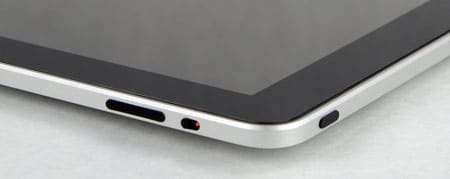
The controls on the top right side of the iPad body: volume, lock and power.
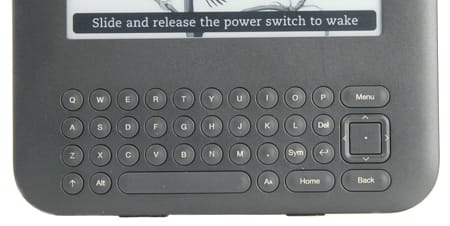
New to Android Jelly Bean is a keyboard that incorporates many of the best features of Swype right in the stock software. Don't like hunting and pecking on a large keyboard? Swipe your finger to each letter without removing it from the screen and type much faster! There's also the option of voice-typing, and Google's program actually does an impressive job of making this a viable solution: just remember to enunciate so the program can transcribe what you're saying accurately.
Connectivity
{{section_header}}{{section.name}}{{/section_header}}
One of the things that owners of the {{product.name}} will find out over a long period of time is just exactly how much is crammed into the tablet. For example, not only does it have bluetooth 4.0 for pairing accessories like keyboards, but it also has 802.11n wireless internet, a microHDMI and microUSB port, a 3.5mm audio jack, a barometer, GPS for navigation (you can cache maps along a pre-planned route so you can use this in the car), and near-field communication. The last of these can be fun, though their most popular application is the Google Wallet app, which you really can't use with the {{product.name}}. It's too damned big to use in a store.

Here we see a Lightning dock in its natural habitat.
Perhaps the most interesting thing is how each of those capabilities is used on the tablet. Unlike iOS, Android has many apps that focus on replacing proprietary functions to give the user the choice in how they connect their devices. For exmaple, if you don't want to use a USB cable to transfer files, you can always use the free app AirDroid to do so over your network. You can also make use of collaborative document editing and sharing for free with Google's Drive app that integrates with GMail. Be sure to explore some of these options if you do grab an Android tablet.
Battery Life
{{section_header}}{{section.name}}{{/section_header}}
After subjecting the {{product.name}} to a series of battery tests, we've concluded that it does a fairly good job of maintaining a charge, though the screen is a bit of a power hog. In our labs, the {{product.model}} was able to read War and Peace for 6 hours, 39 minutes, and it was able to play one of the worst movies of all time for 5 hours, 57 minutes. Because we perform these tests at full backlight and all wireless/extra processes disabled, your mileage may vary in terms of battery life, and in fact we experienced this for ourselves.
There are many strategies you can use to increase your battery life, like turning down the backlight, but one of the many different capabilities that you earn by buying a Nexus device is the ability to root it and install your own ROM on there. Some of these have been purported to use less juice for basic tasks, but of course, doing this comes with its own risks. If you don't know what I'm talking about, you should probably not venture out into the world of hacking your tablet until you learn a bit more.
Reading Books
{{section_header}}{{section.name}}{{/section_header}}
Because the {{product.name}} uses the latest version of the Android operating system Jelly Bean, the best apps on the Play Store are available to you if you don't want to use Google Play Books, which is impressive in its own right. For most apps, you can tap or swipe your finger to turn pages forward or backward, call out menus to change the text size and color, and even share passages over social media.
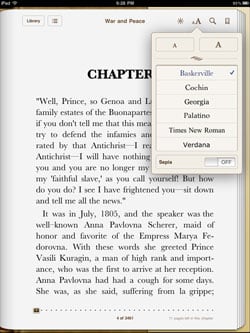
The iBooks program offers a range of controls for font and text size
Buying Books
{{section_header}}{{section.name}}{{/section_header}}
Buying books on the {{product.name}} is just as easy as it is on any other flagship tablet: simply choose your app of choice, and link your account with billing info. Once this is accomplished, your credit card will automatically be charged whenever you find a title you like, and hit the "buy" icon. Because text files are so tiny, your download will begin shortly, and you'll be reading in no time! It only took 1.7 seconds to download Tolstoy's War and Peace here in the labs, for perspective.
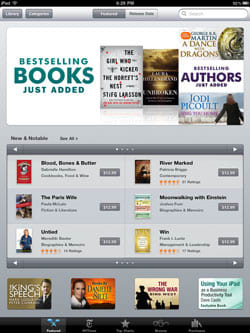
Books can be purchased on the iPad through the iTunes store
eBook Formats
{{section_header}}{{section.name}}{{/section_header}}
Because the {{product.name}} has native file support for most document types, if you do manage to run into a filetype that doesn't work with your current software, chances are extremely good that you can find an app in the Play Store that can handle it. This is especially useful if you're moving to a tablet from an eReader, as the manufacturers for the most popular eReaders often have apps in the Play Store to import your library to.
{{product.manufacturer_specs['eBook Formats Image']}}
Newspapers & Magazines
{{section_header}}{{section.name}}{{/section_header}}
Periodicals work much in the same way that eBooks do, because eReader apps include newspapers and magazines to buy from their stores. Additionally, you can use apps like Google Currents, or Flipboard to read online news for free like you would a magazine.
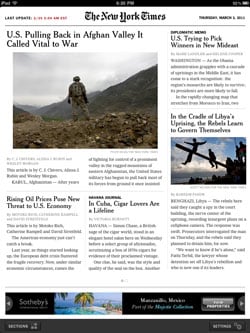
The New York Times is available on the iPad through their own app
Music & Audio Controls
{{section_header}}{{section.name}}{{/section_header}}
If you elect to use the stock music player app for the {{product.name}}, you won't be disappointed. The control scheme doesn't throw anything at you that is very confusing, and the whole interface is very beautiful with transparencies and more intuitive layouts. When it comes down to controlling a song, you'll have the same standard track forward/backward icons, as well as a play/pause icon and a scrub bar.
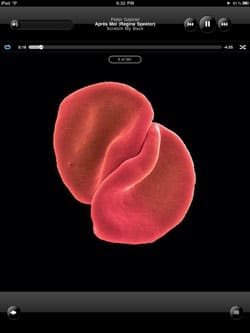
The iPod app shows the cover art while playing music
For advanced playback, there's a menu in the top right of your screen that will allow you to equalize your playback (to a degree), make playlists, and manage your music streaming. You should be aware that Google allows you to use 20GB of storage on their cloud servers for this app, so you can stream your library wherever you have a connection. Should you not like the Google Play Music app, there are other music players on the Play Store.
Music & Audio Management
{{section_header}}{{section.name}}{{/section_header}}
Aside from having its own folder on your tablet, music files can be managed by the Play Music app in one of several ways. For example, you can have your music displayed in a cover flow that you can thumb through much like you would a stack of records, or you can have the ever-boring list format. It's up to you, but be sure to try each option.
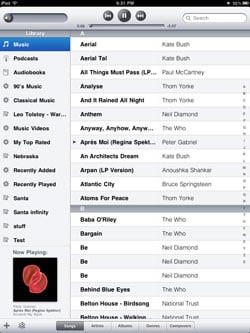
Audio files can be sorted by title, artist, album, genre or composer
Video Controls
{{section_header}}{{section.name}}{{/section_header}}
Watching video files and movies on the {{product.name}} is a rewarding experience, because the tablet makes sure you get the most screen real estate possible. Not only are the on-screen controls very simple, but they also disappear after a few moments to allow you to watch your movie unmolested by translucent overlays.

Video Management
{{section_header}}{{section.name}}{{/section_header}}
Movie files are automatically deposited in a folder with the same name. If at any point you'd like to re-watch them, you can either use the Play Movies app to sift through thumbnails, or you can use the gallery function to browse all of your image-related files.
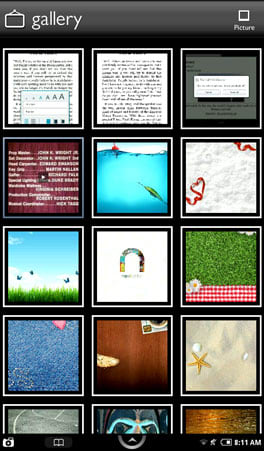
The gallery is used to navigate videos, and only offers thumbnails
Video Formats
Internet Video
{{section_header}}{{section.name}}{{/section_header}}
Now missing from Apple's lineup of apps, the {{product.name}} has the venerable YouTube app, which grants users a very intuitive interface for browsing the vast treasure trove of its library. There are also other apps like Netflix and Play Movies which allow you to play movies from their respective streaming services wherever you have a strong enough WiFi signal.

Video Battery Life
{{section_header}}{{section.name}}{{/section_header}}
If you use multiple inboxes that are spread over POP3/IMAP/Exchange or Gmail, the {{product.name}}'s email app can handle them all- just follow the wizard, and you'll be able to access your email automatically from that point on. The Gmail app is worthy of special note, however, as it makes the experience a little more tablet-friendly, and more efficiently uses the large screen.
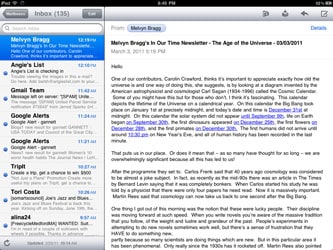
The iPad email app is basic, but adequate for most users
Web Browsing
{{section_header}}{{section.name}}{{/section_header}}
Those of you who are familiar with the Chrome browser on a Mac or PC should be interested to know that the {{product.name}} comes with the browser pre-installed on the device as the default browser. While you can replace it, it offers most of the main features of the desktop version of the software, and if you link an account with it, you can share tabs, bookmarks, and other information across all of your platforms.
If you really don't like it, you can always check out other browsers, as there are a decent array in the Play Store. The Dolphin browser gets a lot of attention from those in the know, so check it out!
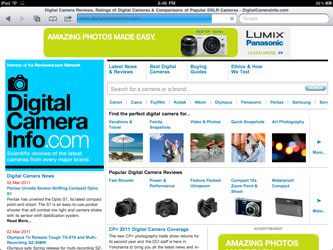
The iPad boasts a fully featured Safari web browser
While Chrome is a decent browser by all accounts, users of tablets with Android 4.0 Ice Cream Sandwich may lament the loss of the original browser, which was not only lighter, but had access to some fairly inventive labs that could be used to enhance the browsing experience on a tablet by building the controls around how a user typically interacts with their devices.
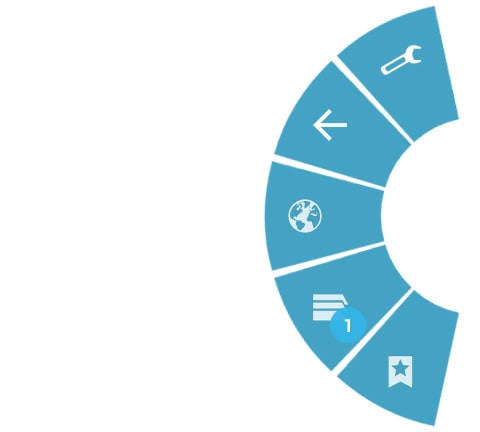
Why Google abandoned these is a mystery, but who knows? Things change fast in the Android world, and maybe we'll see things like the Quick controls again at a later date.
Internet Apps
{{section_header}}{{section.name}}{{/section_header}}
For a long time the major knock on Android tablets was the lack of tablet-specific apps, and the tendency to have a huge number of rescaled phone apps on a tablet, which is just plain terrible. It appears that by fielding a serious tablet platform, Google is looking to attract developers to make more tablet apps.

Apps are found on the Play Store, and a few are pre-installed on your tablet: they're all located in the app drawer, and shortcuts are on the home screen if you decide to place them there. In order to buy, all you have to do is link a credit card to your Google account, and tapping the "buy" icon will automatically bill your card. No matter what app you use, the bottom black bar with the system controls will always be there, meaning you don't have to hunt for possibly missing controls like in some iOS apps.
Other Internet Features
{{section_header}}{{section.name}}{{/section_header}}
With an NFC chip, bluetooth, and an embarrassment of capabilities and hardware, the {{product.name}} can be used in ways that most users will never think of. To that end, we implore to explore the capabilities this hardware platform offers, especially if you're a developer: this thing has a damned barometer on it, maybe make an app that warns you about the likelihood of rain? There are tons of features that apps can use that will make your tablet your window to the virtual world.
{{product.manufacturer_specs['Other Internet Features Image']}}
Conclusion
If you're looking for an Android answer to the iPad, the {{product.name}} is it. With a higher pixel density, the best software and a slew of features, the {{product.model}} makes a statement amid a large number of tablet releases.
While it is true that this tablet is an impressive piece of hardware, there are a couple strange deficiencies that are a little surprising in the performance department. For example, the color gamut is very lacking in comparison to even that of the Nexus7, and a dearth of tablet-specific apps will continue to frustrate Android users for the time being, essentially wasting that pixel-packed display.
All that being said, the most recent upgrade to Android Jelly Bean (4.2) offers a crazy amount of inventive and captivating features, all with the same customizability and pedigree of a stock Android device. Don't like something? Change it! Love another feature? Make it better! Additionally, you will always have the latest and greatest version of the Android operating systems, as Google's Nexus program ensures it. There is no other Android tablet save for the Nexus7 that offers this kind of longevity and feature arsenal.
If you are curious about making the leap to an Android tablet, there's never been a better time than now after the latest Nexus line of tablets and phones have been released. While they're not perfect, they do offer quite a lot for the pricetag, and it's hard to argue when it's less expensive than its nearest competitors of any operating system.
Meet the tester
A seasoned writer and professional photographer, Chris reviews cameras, headphones, smartphones, laptops, and lenses. Educated in Political Science and Linguistics, Chris can often be found building a robot army, snowboarding, or getting ink.
Checking our work.
Our team is here to help you buy the best stuff and love what you own. Our writers, editors, and experts obsess over the products we cover to make sure you're confident and satisfied. Have a different opinion about something we recommend? Email us and we'll compare notes.
Shoot us an email

